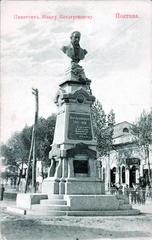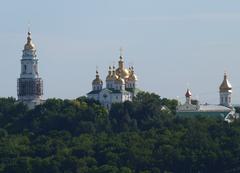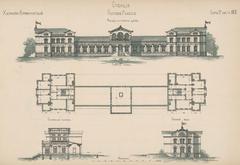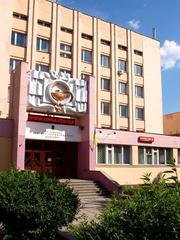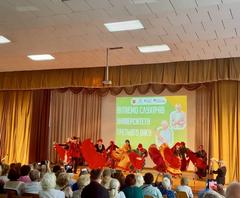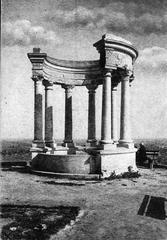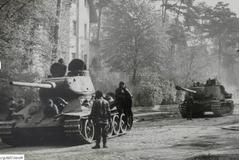
Comprehensive Guide to Visiting Poltava, Poltava Oblast, Ukraine
Date: 13/08/2024
Captivating Introduction
Welcome to Poltava, a city where history and culture blend seamlessly, creating an enchanting tapestry of experiences that beckon every traveler. Imagine stepping into a living history book, where the cobblestone streets whisper tales of Cossack warriors and ancient battles, all set against the backdrop of the scenic Vorskla River. Poltava is not just a city; it’s a journey through time, offering a rich narrative that spans from the Paleolithic era to modern marvels. (Britannica)
As you stroll through this charming city, you’ll encounter a vibrant blend of historical landmarks, cultural treasures, and hidden gems that make Poltava a must-visit destination. Picture this: the majestic Holy Cross Convent, the serene Botanical Garden, and the awe-inspiring Exaltation of the Cross Cathedral—all waiting to be explored. And let’s not forget the epic Battle of Poltava, a defining moment that reshaped European history. (Wikipedia)
But Poltava is more than its past; it’s a living, breathing entity teeming with contemporary art, culinary delights, and vibrant festivals. Whether you’re a history buff, an art lover, or a foodie, Poltava offers something for everyone. Ready to embark on an unforgettable journey? Let’s dive into the heart of Poltava, where every corner holds a story, and adventure awaits at every turn.
Table of Contents
- Discover Poltava: A Journey Through Time with a Witty Local Guide
- Unearthing the Paleolithic Secrets
- Medieval Drama: Thrones, Wars, and Cossacks
- The Epic Battle of Poltava
- From the 18th Century to the Glorious 19th
- 20th Century Adventures and Modern Marvels
- Cultural Treasures and Hidden Gems
- Insider Tips for the Savvy Traveler
- Seasonal Charms and Local Lingo
- Myth Busting and Surprises
- Your Poltava Adventure Awaits!
- Cultural Significance
- Historical Evolution and Cultural Development
- Literary and Artistic Contributions
- Architectural Landmarks
- Traditional Crafts and Folk Art
- Cultural Events and Festivals
- Museums and Memorials
- Educational Institutions and Intellectual Life
- Local Secrets and Hidden Gems
- Sensory Descriptions
- Interactive Elements
- Cultural Context and Etiquette
- Practical Information with a Twist
- Pop Culture References
- Time-Based Itineraries
- Local Lingo Lessons
- Seasonal Highlights
- Myth Busting and Surprises
- Storytelling Elements
- FAQ
- Call to Action
- Visitor Tips
Discover Poltava: A Journey Through Time with a Witty Local Guide
Unearthing the Paleolithic Secrets
Poltava’s history is ancient—like, really ancient. Imagine our ancestors chilling in Paleolithic dwellings, probably swapping hunting tips and making stone tools. Archaeologists have uncovered Scythian remains here, whispering tales of the distant past. The city first appeared in records in 1174 as Oltava or Ltava. (Pro tip: if you meet a time traveler, that’s what you should call it!) (Britannica)
Medieval Drama: Thrones, Wars, and Cossacks
In the 14th century, Poltava was part of the Duchy of Kyiv, a vassal of the Grand Duchy of Lithuania. By 1430, the Lithuanian duke Vytautas handed it over to Murza Olexa, a noble from the Golden Horde. In 1482, Crimean Khan Mengli I Giray razed Poltava. It later joined the Polish Crown in 1569 and became a Cossack hotspot in the 17th century. Poltava was a key player in the Khmelnytsky Uprising against Polish rule in 1648, becoming a Cossack stronghold. (Wikipedia)
The Epic Battle of Poltava
One of the most defining moments in Poltava’s saga is the Battle of Poltava on July 8, 1709 (or June 27, if you’re old-school). Peter I of Russia faced Charles XII of Sweden in a showdown that marked the decline of Swedish power and the rise of Russia as a European titan. (Wikipedia)
From the 18th Century to the Glorious 19th
The 18th century kept Poltava on its toes. In 1695, Petro Ivanenko led an anti-Muscovite uprising with Crimean Tatar help. The Poltava Regiment also participated in the Azov campaigns, capturing the Turkish fortress of Kyzy-Kermen. By 1802, Poltava was hitting its stride as a provincial center, with a stunning semicircular Neoclassical square and the majestic Tuscan column of cast iron, commemorating the centenary of the Battle of Poltava. Psst, check out the 18 Swedish cannons displayed there. (Wikipedia)
20th Century Adventures and Modern Marvels
The 20th century was a rollercoaster for Poltava, with the Russian Revolution, two World Wars, and Soviet-era industrialization. But amidst the chaos, the city flourished. The five-domed Exaltation of the Cross Cathedral, a Cossack Baroque masterpiece built between 1699 and 1709, stands as a testament to its resilience. Despite some losses, like the Dormition of the Theotokos church in 1934, Poltava’s spirit endured. (Wikipedia)
Cultural Treasures and Hidden Gems
Poltava’s cultural scene is as vibrant as its history. Dive into the Poltava Art Museum, the Museum of the History of the Poltava Battle, and the Museum-estate of Ivan Kotlyarevskyi for a dose of art, military lore, and literary brilliance. (Wanderlog)
But wait, there’s more! The Holy Cross Convent and the Botanical Garden of Poltava National Pedagogical University are must-sees, along with green havens like Poltava City Park and Park Victory. Relax, unwind, and soak in the local vibe. (Wanderlog)
Insider Tips for the Savvy Traveler
Ready to explore? Don’t miss the Poltava Local Lore Museum and the Museum of the History of the Poltava Battle—perfect for history geeks. Check out the Holy Cross Convent and the Exaltation of the Cross Cathedral for a spiritual and architectural treat.
Stroll through the semicircular Neoclassical square and admire the Tuscan column. Snap selfies with the Swedish cannons and feel the echoes of history. Literature lovers, hit up the Museum-estate of Ivan Kotlyarevskyi and the Literary-Memorial Museum P. Myrnoho for a literary pilgrimage.
Seasonal Charms and Local Lingo
Poltava is a year-round wonder. Spring blooms, summer festivals, autumn hues, and winter coziness—there’s never a dull moment. And while you’re here, impress the locals with a few phrases: “Dobryi den” (Good day) and “Dyakuyu” (Thank you). They’ll love it!
Myth Busting and Surprises
Think you know Poltava? Think again! Did you know it’s a hotspot for UFO sightings? Or that it hosts an annual dumpling festival? Poltava is full of surprises, waiting to be discovered.
Your Poltava Adventure Awaits!
So, pack your bags and get ready for an unforgettable journey through Poltava. Let Audiala be your guide, offering beautifully crafted audio tours that bring the city’s history and culture to life. Download the Audiala app before your visit and unlock Poltava’s secrets. Adventure is calling—are you ready to answer?
Cultural Significance of Poltava
Poltava: The Cultural Kaleidoscope
Welcome to Poltava, a city where history dances with culture, and every street whispers tales of centuries past. Poltava is like that cool, artsy cousin you always wished you had – full of surprises and never a dull moment.
Historical Evolution and Cultural Development
Poltava’s cultural significance is deeply rooted in its historical evolution. The city, first mentioned as Ltava in the Hypatian Chronicle in 1174, has been a witness to numerous historical events and cultural transformations. Archaeological evidence indicates that the site was inhabited as early as the 7th or 6th century BC (Encyclopedia of Ukraine). Over the centuries, Poltava has been part of various states, including the Grand Duchy of Lithuania, the Polish-Lithuanian Commonwealth, and the Hetmanate, each leaving a distinct cultural imprint.
In the last quarter of the 18th century, Poltava began to emerge as a significant cultural center. The establishment of the Poltava Slavonic Seminary (1770–80) and the activities of local intellectuals, such as P. Paskevych, who opened a bookstore selling Russian and foreign publications, contributed to the town’s cultural life (Encyclopedia of Ukraine). By the 19th century, Poltava’s culture had become increasingly Ukrainian, with local figures like Vasyl Kapnist and Vasyl Lukashevych playing pivotal roles in the Ukrainian autonomist movement.
Literary and Artistic Contributions
Poltava has a rich tradition in literature and the arts. The city is the birthplace of renowned poet Ivan Kotliarevsky, whose works have left an indelible mark on Ukrainian literature (Facts.net). Kotliarevsky’s home has been converted into a museum, offering visitors a glimpse into his life and contributions.
The Poltava Regional Art Museum houses a diverse collection of artworks, including paintings, sculptures, and decorative arts from various periods and styles (Facts.net). This museum is a testament to the city’s vibrant artistic heritage and its ongoing commitment to preserving and promoting Ukrainian culture.
Architectural Landmarks
Poltava is known for its unique architectural landmarks, which reflect its rich cultural heritage. The Holy Cross Exaltation Monastery and the Assumption Cathedral are prime examples of the city’s religious architecture (Facts.net). These structures not only serve as places of worship but also as symbols of the city’s historical and cultural continuity.
The city also boasts remnants of its fortifications, which played significant roles in various military conflicts throughout history. These historical structures offer insights into Poltava’s strategic importance and its resilience in the face of adversity (Facts.net).
Traditional Crafts and Folk Art
Poltava is famous for its traditional embroidery, a craft that showcases the beauty of Ukrainian folk art. The region’s skilled embroiderers create intricate designs that are highly valued for their artistic and cultural significance (Facts.net). Visitors can explore local markets and shops to purchase these exquisite pieces, which make for unique and meaningful souvenirs.
Cultural Events and Festivals
Poltava’s cultural calendar is filled with events and festivals that celebrate its rich heritage. Traditional Ukrainian festivals, such as the Ivan Kupala Night and the Malanka Festival, are celebrated with great enthusiasm, offering visitors a chance to immerse themselves in local customs and traditions (Travopo). These events often feature folk music, dance performances, and traditional cuisine, providing a comprehensive cultural experience.
Museums and Memorials
Poltava is home to several museums and memorials that commemorate its historical and cultural milestones. The Poltava Battle Museum, located on the site of the historic Battle of Poltava, provides detailed insights into this significant event and its impact on European history (Facts.net). The museum complex includes exhibits, dioramas, and artifacts that vividly depict the battle and its aftermath.
Another notable site is the memorial complex dedicated to the Battle of Poltava, which serves as a poignant reminder of the city’s military history and its role in shaping the region’s destiny (Facts.net).
Educational Institutions and Intellectual Life
Poltava has a long-standing tradition of intellectual and educational excellence. The city is home to several institutions of higher learning, including the Poltava National Technical University and the Poltava State Agrarian Academy. These institutions contribute to the city’s vibrant intellectual life and play a crucial role in fostering a culture of learning and innovation (Encyclopedia of Ukraine).
Local Secrets and Hidden Gems
Don’t miss the hidden courtyard café behind the Poltava Art Museum – a perfect spot for a quiet coffee. Or, take a walk through the lesser-known streets and discover charming boutiques and local artisans selling unique crafts.
Sensory Descriptions
Feel the cobblestones underfoot as you walk through Poltava’s historic district, and let the aroma of fresh pastries lure you into a local bakery. Hear the melodies of street musicians as you explore the city’s vibrant squares.
Interactive Elements
Challenge: Find the oldest tree in Poltava and take a selfie with it! Share your picture with the hashtag #PoltavaAdventures for a chance to be featured on our social media.
Cultural Context and Etiquette
When greeting locals, a firm handshake and a smile go a long way – just don’t forget to say ‘Dobryi den’! It’s also customary to leave a tip of around 10% of the bill in restaurants and cafes as a token of appreciation for good service, although tipping is discretionary (1Map).
Practical Information with a Twist
Getting around Poltava is a breeze – hop on a tram or bus, and you’ll be exploring like a local in no time! Walking tours are also a great way to discover the city’s hidden gems and architectural marvels.
Pop Culture References
Fans of history might recall Poltava’s mention in classic literature – it’s like stepping into the pages of a timeless novel. The city’s rich past is a backdrop for countless stories waiting to be discovered.
Time-Based Itineraries
Choose Your Adventure: A Day in Poltava – Start with a historical tour in the morning, followed by an art crawl in the afternoon. End your day with a cozy dinner at a local restaurant, sampling delicious Ukrainian cuisine.
Local Lingo Lessons
Learn to say ‘Pryvit’ (Hello) and ‘Yak spravy?’ (How are you?) – it’s your ticket to friendly local exchanges! A few basic Ukrainian phrases or carrying a translation app can enhance communication with locals and provide a more immersive cultural experience (1Map).
Seasonal Highlights
In winter, Poltava turns into a snowy wonderland – perfect for cozying up with a cup of hot mulled wine. Each season brings its own charm, from the vibrant colors of autumn to the blooming flowers of spring.
Myth Busting and Surprises
Contrary to popular belief, Poltava isn’t just about history – it’s a thriving hub of contemporary art and culture. Discover modern galleries and innovative performances that showcase the city’s dynamic spirit.
Storytelling Elements
Legend has it that the Battle of Poltava was decided by a single, clever strategy – visit the battlefield to uncover the full story. These tales of bravery and brilliance bring the past to life.
FAQ
FAQ: What’s the best way to get around Poltava? Our answer: Trams and buses are affordable and convenient!
Call to Action
Download Audiala and let our expert guides reveal Poltava’s secrets and stories – your perfect travel companion awaits! Audiala offers beautifully crafted, concise yet deep audio guides that enhance the exploration experience.
Conclusion
Poltava’s cultural significance is a tapestry woven from its rich history, literary and artistic contributions, architectural landmarks, traditional crafts, and vibrant cultural events. By exploring these facets, visitors can gain a deeper understanding of the city’s unique heritage and its enduring impact on Ukrainian culture.
Visitor Tips for Poltava, Poltava Oblast, Ukraine
Introduction
Welcome to Poltava, a city where history and culture intertwine, creating an unforgettable tapestry of experiences. Imagine a place where the echoes of ancient battles resonate through charming streets, and every corner holds a story. Let’s dive into the heart of Poltava, where adventure awaits!
Transportation
Navigating Poltava is a breeze with these options:
- Public Transportation: Hop on a bus, trolleybus, or tram and immerse yourself in the local vibe. Tickets are cheap and can be snagged from the driver or nearby kiosks.
- Taxis: Hail a cab or summon one via Uber or Bolt for a quick ride. It’s convenient but might dent your wallet more than a bus ride.
- Walking: Lace up your comfy shoes! The city center is compact, making it perfect for a leisurely stroll.
- Cycling: Rent a bike and pedal through Poltava’s scenic trails. It’s eco-friendly and great for your health!
- Private Car: If you’re up for a driving adventure, rent a car. Just remember, parking can be a puzzle in the city center.
Accommodation
Rest easy with Poltava’s diverse lodging options:
- Hotels: From budget-friendly to luxurious, there’s a hotel for every traveler. Book ahead, especially during peak times.
- Hostels: Ideal for budget explorers, these spots offer basic amenities and a chance to meet fellow travelers.
- Guesthouses and B&Bs: Enjoy ahomely stay with local hosts sharing insider tips.
- Vacation Rentals: Need more space? Airbnb has you covered with homes and apartments for a comfy stay.
Safety Tips
Stay safe and sound with these tips:
- Stay Aware: Keep your wits about you, especially in crowded spots.
- Secure Belongings: Watch out for pickpockets. Use anti-theft bags and keep valuables out of sight.
- Avoid Unsafe Areas: Stick to well-lit, populated streets at night.
- Respect Laws and Customs: Follow local rules to stay out of trouble.
- Keep Documents Safe: Store copies of important documents in a secure place.
- Check Travel Advisories: Stay updated with government travel advisories.
Best Time to Visit
Poltava is a gem year-round, but late spring (May-June) and early autumn (September-October) are especially delightful. Summers can sizzle, and winters bring a snowy wonderland, though it might limit outdoor fun.
Local Cuisine
Treat your taste buds to Poltava’s culinary delights:
- Varenyky: Delightful dumplings stuffed with potatoes, cheese, or sauerkraut, served with sour cream.
- Deruny: Crispy potato pancakes, perfect for a savory snack.
- Salo: Thinly sliced cured pork fat, a local favorite often paired with bread and mustard.
- Borscht: Hearty beet soup, a Ukrainian staple.
- Halushky: Poltava’s own dumplings, served with a variety of toppings.
Cultural Etiquette
Blend in with the locals by following these tips:
- Greetings: A firm handshake and “Dobryi den” (Good day) go a long way.
- Dress Code: Dress modestly at religious sites. Casual attire is fine elsewhere, but some spots might require formal wear.
- Tipping: Not mandatory, but a 10-15% tip is appreciated for good service.
- Language: Ukrainian is the official language, but many also speak Russian. Learning a few phrases in Ukrainian can win you smiles.
Attractions and Activities
Discover Poltava’s treasures:
- Poltava Battle Museum: Dive into history at this museum dedicated to the Battle of Poltava.
- Ivan Kotlyarevsky Museum: Explore the life of the famed Ukrainian writer.
- Poltava Art Museum: Admire local and national artworks.
- Round Square: A central hub with stunning architecture.
- Assumption Cathedral: Marvel at this Baroque beauty.
- Korolenko Museum: Learn about writer Vladimir Korolenko.
Events and Festivals
Join in the local festivities:
- Poltava Dumpling Festival: Celebrate with dumplings galore, cooking contests, and performances.
- Music and Art Festivals: Enjoy live music and art displays from local talents.
- Historical Reenactments: Witness the Battle of Poltava come to life.
Shopping
Shop till you drop in Poltava:
- Local Markets: Find fresh produce, crafts, and souvenirs at the Central Market.
- Shopping Malls: Visit malls like “Kiev” and “Equator” for a mix of brands.
- Souvenir Shops: Pick up traditional crafts, embroidery, and local treats.
Health and Wellness
Stay healthy with these tips:
- Medical Facilities: Poltava has hospitals and clinics. Travel insurance is a wise choice.
- Pharmacies: Widely available, but bring any specific meds you need.
- Water and Food Safety: Tap water is safe, but bottled water is available. Opt for well-cooked food.
Connectivity
Stay connected effortlessly:
- Internet: Free Wi-Fi in hotels, cafes, and restaurants. Mobile data is affordable too.
- SIM Cards: Buy local SIMs from Kyivstar, Vodafone, or Lifecell.
Emergency Contacts
Keep these numbers handy:
- Police: 102
- Ambulance: 103
- Fire Department: 101
- Tourist Information Center: For assistance and info.
Call to Action
Unlock Poltava’s secrets with Audiala, your ultimate tour guide app. Discover hidden gems and expert insights with beautifully crafted audio guides. Download Audiala and let the adventure begin!
Conclusion
Poltava is a city that captivates with its rich tapestry of history, culture, and modern vibrancy. From its ancient Paleolithic roots to its pivotal role in European history, Poltava offers a comprehensive experience that is both educational and enchanting. The city’s cultural landmarks, such as the Poltava Art Museum and the Museum of the History of the Poltava Battle, provide deep insights into its storied past, while its lush parks and vibrant festivals showcase its dynamic present. (Wanderlog)
As you explore Poltava, you’ll discover not just a city, but a living narrative filled with hidden gems, local secrets, and sensory delights. From the aroma of freshly baked varenyky to the vibrant melodies of street musicians, every moment in Poltava is a feast for the senses. And with the Audiala app as your guide, you can unlock the city’s secrets and stories, making your journey even more enriching. So pack your bags, download Audiala, and set forth on an adventure through Poltava that promises to be unforgettable. (1Map)
References
- Britannica, n.d., Poltava
- Wikipedia, n.d., Poltava
- Wanderlog, n.d., Top things to do and attractions in Poltava
- 1Map, n.d., Travel guide to Poltava



















